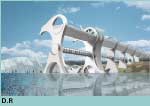 |
Editorial |

 |
Network
news |



 |
Life
on the canals |



|
|

|
|
| |
NETWORK
NEWS

Canals :
an asset for sustainable development
|

Attending a seminar in Brussels on 18/11/99, organised for the partners
of the TERRA programme, VEV delegates were invited to reflect on
"indicators" of performance of historic canals and navigations,
particularly from the standpoint of sustainable development.
Eighty actors of the TERRA programme met in Brussels in November
for a day of brainstorming on "indicators as tools for management
and monitoring of processes for planning sustainable local and regional
development". This apparently forbidding task definition was
followed by a question of disarming simplicity to which the delegates
tried to answer: "How useful are they?".
Umberto Vascelli Vallara for Lombardy, Jean-Pierre and Anne Gailliez
for Wallonia and David Edwards-May, technical assistant delegated
by Midi-Pyrenees regional council, attended a series of presentations
which threw new light on the projects undertaken by the VEV partners.
The approach was inspired by one of the leading TERRA projects,
SDTP (Sustainable Development Through Planning), a network which,
like VEV, concerns a broad panel of regions through the EU.
The European Commission wanted to draw the attention of the greatest
number to the work done by this partnership, led by Tees Valley
Council (North-East England), which sought to apprehend the "nitty
gritty" of planning processes, with a view to deriving transferable
theories. Among the many other enlight- ening talks, Clive Gilbert
(Kent County Council) had identified 69 indicators of quality of
life of the county's inhabitants, but feedback forced planners to
reduce the number to ensure efficiency of the process, while Mireille
Grubert of DG REGIO, responsible for the Urban programme, described
the work in progress on quality of life indicators in 58 towns (the
biggest in the EU, excluding Paris and London).
This seminar will have been valuable for the VEV partnership, first
by recalling the contours of the vast project within which our own
work forms just one of the "building blocks". Perhaps
more significantly, it will have provided a vision for the future.
After analysing all the results of the TERRA programme, the Commission
is expected to adopt one or several projects which will have proved
particularly promising in terms of regional development, for new
community-funded programmes.
Finally, it will have stimulated our own reflection. What indicators
do we have to appreciate the value of our heritage of historic canals?
Several research programmes, particularly those undertaken by Linköping
University and British Waterways, are aimed precisely at providing
indicators. One of the issues at the closing conference in Toulouse
in October 2000 could be to propose a synthesis between the "quality
of life" indicators, perhaps corresponding to the political
perspective, and "socio-economic performance" indicators,
which waterway authorities seek to identify and evaluate, in support
of their submissions for funding investments or the equivalent of
a "public service obligation" in operating their networks.
This is another example of the scope and ambition of the VEV network:
starting from the necessarily contrasted viewpoints of the regional
institutions and the bodies managing the canals on behalf of the
nation, the objective is to forge a consensus. Our work takes place
against a backdrop of major change, with key players jostling for
position, and many hard questions being asked. This is the case
in Sweden, for example, where the outcome of one study could be
to recommend broadening the ownership structure of the Göta
Canal, currently run by a central government department. Another
observation is that our project is eminently "sectoral":
does it not amount to defending the interests of one type of transport
infrastructure, traditionally the poor relation of public sector
transport investments? We clearly do not have the same detachment,
the same broad view as some of the other TERRA projects. Is this
to be regretted? Certainly not! We may even feel proud of this eccentricity,
especially as the way of life offered by historic canals to all
users is in total harmony with the ESDP's objectives of sustainable
regional development. We have nine months left to unravel the knots
of our common history and propose our own indicators !


|
|
|
